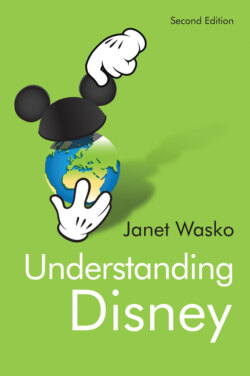Читать книгу Understanding Disney - Janet Wasko - Страница 16
Hooray for Hollywood
ОглавлениеOnly a few of Walt Disney’s biographers attempt to establish any context for the company’s achievements. Indeed, many profiles give him so much credit for animation innovations that one would think that animation originated with Walt Disney.23 But, as Watts suggests:
Disney’s success cannot be understood as an isolated event. It unfolded as part and parcel of much larger cultural changes in the early twentieth century. Shaped by the rise of consumerism in the economic realm, bureaucracy in the social structure, and corporate liberalism in politics, an enormous historical transformation had reworked the meaning of entertainment and the definition of success.24
Indeed, motion pictures in general and Disney in particular represented examples of these changes. The Disney company was part of the growing motion picture business that had emerged in the Los Angeles area from about 1910. What is also overlooked in many of the Disney histories is how small the Disney company actually was by comparison with the corporate giants that controlled the film industry at the time. In the early 1930s, the industry was dominated by five fully integrated corporations – Fox, Paramount, Loew’s, RKO, and Warner Brothers – that produced and distributed motion pictures to their theater chains around the country. Meanwhile, three smaller companies – United Artists, Columbia, and Universal – produced and distributed films in cooperation with the Big Five.25
Although the Disney studio received an enormous amount of public attention and was proclaimed to be an amazing success, it was only a pint-sized midget compared to these other incorporated giants that produced hundreds of films each year and amassed sizable revenues and profits. Under its distribution agreement with United Artists, the Disney company produced between 20 and 25 short films annually, for about $50,000 each, with expected revenues of about $120,000 each. However, distribution costs reduced the ultimate profits for the Disney firm. During the 1930s, the Disneys rarely made a profit of more than $500,000 per year, and this was poured back into production.
Gomery reminds us that the Disney brothers were able to survive for three reasons: (1) distribution deals with some of the major film companies (Columbia, 1929–31, United Artists, 1931–36, and RKO, 1936–54); (2) product differentiation, including short subjects which took advantage of technological innovations such as sound and color; and (3) revenues from merchandising contracts (the company received 2.5 percent royalties on inexpensive products, 5 percent on expensive items).26 For these reasons, the Disneys were able to hang on as a small Hollywood independent in an industry controlled by much larger, integrated corporations.
